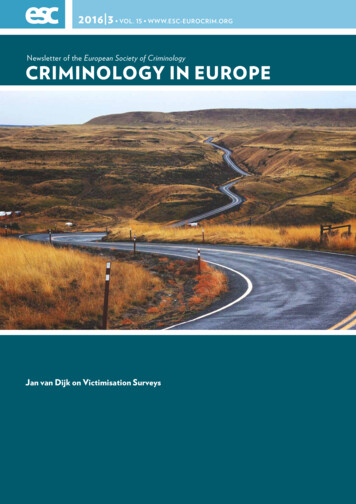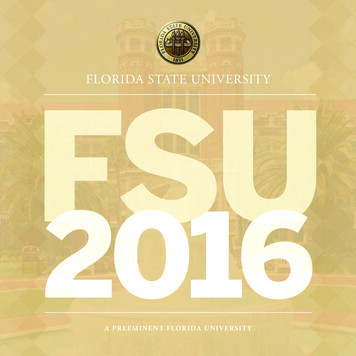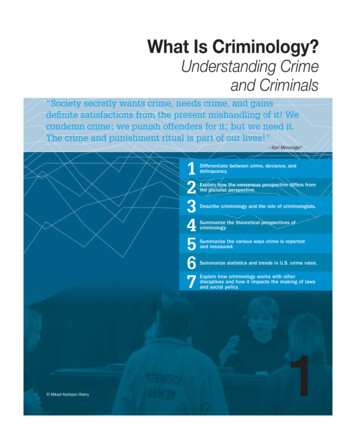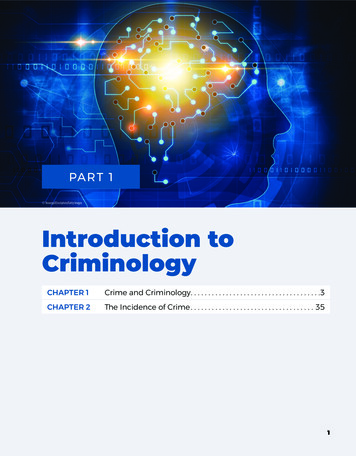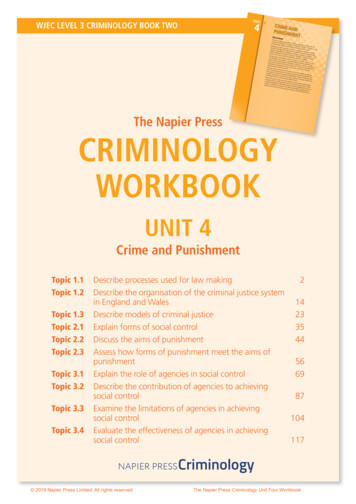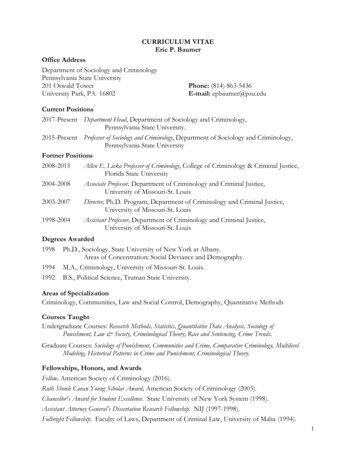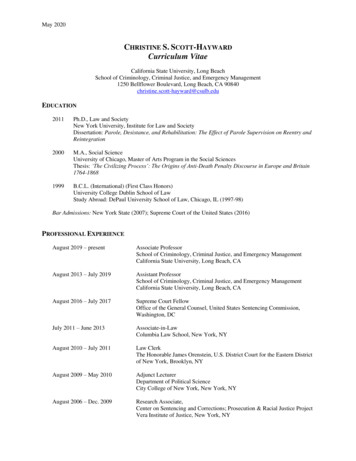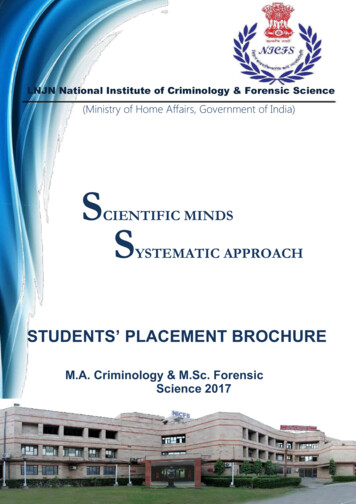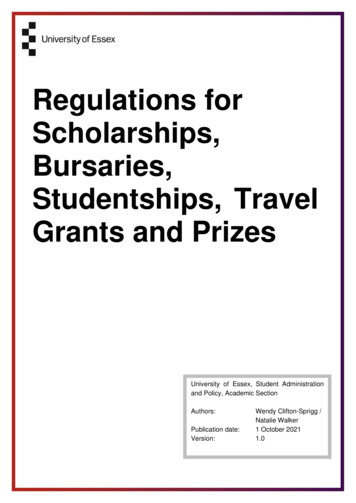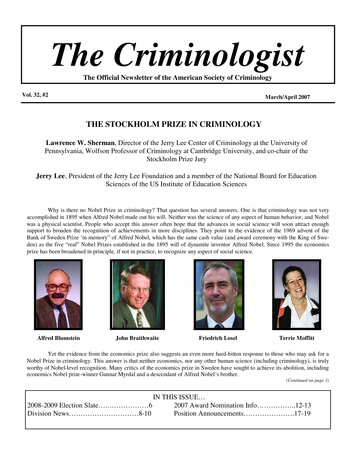
Transcription
Page 1The CriminologistThe CriminologistThe Official Newsletter of the American Society of CriminologyVol. 32, #2March/April 2007THE STOCKHOLM PRIZE IN CRIMINOLOGYLawrence W. Sherman, Director of the Jerry Lee Center of Criminology at the University ofPennsylvania, Wolfson Professor of Criminology at Cambridge University, and co-chair of theStockholm Prize JuryJerry Lee, President of the Jerry Lee Foundation and a member of the National Board for EducationSciences of the US Institute of Education SciencesWhy is there no Nobel Prize in criminology? That question has several answers. One is that criminology was not veryaccomplished in 1895 when Alfred Nobel made out his will. Neither was the science of any aspect of human behavior, and Nobelwas a physical scientist. People who accept this answer often hope that the advances in social science will soon attract enoughsupport to broaden the recognition of achievements in more disciplines. They point to the evidence of the 1969 advent of theBank of Sweden Prize ‘in memory” of Alfred Nobel, which has the same cash value (and award ceremony with the King of Sweden) as the five “real” Nobel Prizes established in the 1895 will of dynamite inventor Alfred Nobel. Since 1995 the economicsprize has been broadened in principle, if not in practice, to recognize any aspect of social science.Alfred BlumsteinJohn BraithwaiteFriedrich LoselTerrie MoffittYet the evidence from the economics prize also suggests an even more hard-bitten response to those who may ask for aNobel Prize in criminology. This answer is that neither economics, nor any other human science (including criminology), is trulyworthy of Nobel-level recognition. Many critics of the economics prize in Sweden have sought to achieve its abolition, includingeconomics Nobel prize-winner Gunnar Myrdal and a descendant of Alfred Nobel’s brother.(Continued on page 3)IN THIS ISSUE 2008-2009 Election Slate . 62007 Award Nomination Info .12-13Division News 8-10Position Announcements .17-19
Page 2AROUND THE ASC2007CONFERENCESAROUND THEAND ASCWORKSHOPS14TH ANNUAL MEETING OF THE INTERNATIONAL POLICE EXECUTIVESYMPOSIUM, April 8-12, 2007, Dubai7th ANNUAL JERRY LEE CRIME PREVENTION SYMPOSIUM, April 23 - 24,2007, presented by The University of Maryland and University of Pennsylvania. To beheld at College Park, MD and Washington D.C. For more information emailccjg@crim.umd.edu or visit http://www.ccjs.umd.edu/ccjgIV SPANISH SOCIETY OF CRIMINOLOGY CONFERENCE, April 26-28, 2007,Málaga, Spain. More Info: htmlJUSTICE STUDIES ASSOCIATION Ninth Annual Conference, Salve Regina University Newport, R.I., June 7-9, 2007. For more information visit http://www.justicestudies.org/NORTH AMERICAN CORRECTIONAL & CRIMINAL JUSTICE PSYCHOLOGY CONFERENCE June 7-9, 2007, Ottawa, CanadaNATIONAL CONFERENCE ON RESTORATIVE JUSTICE June 24-27, 2007Schreiner University, Kerrville, TexasVol. 32, No. 2, March/April 2007The CriminologistThe O ffic ia l N e w s le t t e r o f t heAme ric a n So c ie t y o f C rimino lo gyTHE CRIMINOLOGIST (ISSN 0164-0240) is published six timesannually – in January, March, May, July, September, and Novemberby the American Society of Criminology, 1314 Kinnear Road, Suite212, Columbus, OH 43212-1156 and additional entries. Annual subscriptions to non-members: 50.00; foreign subscriptions: 60.00;single copy: 10.00. Postmaster: Please send address changes to:The Criminologist, 1314 Kinnear Road, Suite 212, Columbus, OH43212-1156. Periodicals postage paid at Toledo, Ohio.Editor: DORIS MACKENZIEUniversity of Maryland at College ParkPublished by the American Society of Criminology, 1314Kinnear Road, Suite 212, Columbus, OH 43212-1156.Printed by Lesher Printers.Inquiries: Address all correspondence concerning newsletter materials and advertising to American Society of Criminology, 1314 Kinnear Road, Suite 212, Columbus, OH43212-1156, (614) 292-9207, asc2@osu.edu.EUROPEAN SOCIETY OF CRIMINOLOGY August 2007, Bologna, ItalyON THE EDGE: TRANSGRESSION AND THE DANGEROUS OTHER: AN INTERDISCIPLINARY CONFERENCE August 9-10, 2007, John Jay College of Criminal Justice and CUNY Graduate CenterTHE SOCIETY FOR THE STUDY OF SOCIAL PROBLEMS (SSSP) 57th AnnualMeeting, August 10-12, 2007, Roosevelt Hotel, New York, NY For more info., pleasevisit http://www.sssp1.org/index.cfm/m/23WHAT WORKS WITH WOMEN OFFENDERS: PRATO - TUSCANY, ITALY,September 10-12, 2007, Contacts: Katy Symmons - Katy.Symmons@med.monash.edu.au, Annabel Whitby - Annabel.Whitby@med.monash.edu.auCENTURY OF PROBATION 2007 INTERNATIONAL CONFERENCE, September 10 - 13, 2007, For further information visit www.centuryofprobation.comASC President: MICHAEL TONRYUniversity of Minnesota Law School229 19th AvenueMinneapolis, MN 55455Membership: For information concerning ASC membership, contact the American Society of Criminology, 1314Kinnear Road, Suite 212, Columbus, OH 43212-1156,(614) 292-9207; FAX (614) 292 -6767; asc@osu.edu; http://www.asc41.comAROUND THE ASCCurtis R. Blakely, an Assistant Professor in the Department of Political Science and Criminal Justice at the8TH NATIONAL CONFERENCE ON PREVENTING CRIME October 3-5, 2007, University of South Alabama has published a new booktitled: Prisons, Penology and Penal Reform: An IntroHilton Atlanta in Atlanta, Georgia www.ncpc.org/NationalConference2007duction to Institutional Specialization (Peter Lang,2007).ARTS IN CRIMINAL JUSTICE NATIONAL CONFERENCE, October 3–6, 2007,Philadelphia, Pennsylvania, Sponsored by the Nathan Cummings Foundation, Hosted byAssociate Professor Dan Mears has been awarded tenPhiladelphia’s internationally renowned Mural Arts Program. For more information:www.artsincriminaljustice.org, Email: info@artsincriminaljustice.org, Phone: (215) 685- ure and Carter Hay has been promoted to associate professor with tenure in the Florida State University Col0759lege of Criminology and Criminal Justice.VENEZUELAN CRIMINOLOGY FORUM, November 1-3, 2007, Maracaibo, VeneThe Florida State University College of Criminologyzuela, Contact Jesús Párraga (jparraga@iamnet.com), Christopher Birkbeck (c.h.and Criminal Justice is continuing its expansion withbirkbeck@salford.ac.uk), www.venecrim.comthe addition of two faculty members for Fall 2007: EricStewart, from the University of Missouri-St. Louis, willCONERENCE OF THE REHABILITATION OF YOUNG OFFENDERSjoin the College as an associate professor. Sarah Bacon,The Ministry of Community Development , Youth and Sports (MCYS) from Singapore,in partnership with the Social Service Training Institute and the Singapore Association of who completed her Ph.D. at the University of Marylandand was a visiting assistant professor at FSU in 2006Social Workers, November 20 - 21, 20072007, is joining the College as a tenure-track assistantContact: Wong Yu-Jin wong yu-jin@mcys.gov.sgprofessor.THE RESEARCH GROUP ON PUNISHMENT OF THE INTERNATIONALCENTER FOR COMPARATIVE CRIMINOLOGY, December 5-7, 2007, “Pain inour Contemporary Society: Permanence or Mutation” Tel : 514 343-2120, Fax: 514 3432269, Email: chloe.leclerc@umontreal.ca
The CriminologistPage 3(Continued from page 1)To impose a criterion that research results should be “worthy” of global recognition, however, is to miss the point of establishing prizes in the first place. It confuses the cart and the horse, as if the prize is a “cart” to be pulled only by a worthy research “horse.” Founders of such prizes have the opposite vision. A prize is not a dependent variable to be caused by the independent variable of outstanding research. A prize, to them, is program X designed to cause better research Y by providing the“horse” of a greater incentive.It was just that horse-pulls-the-cart theory which led the ASC Development Committee in 2001-2002 to promote the ideaof a major prize in criminology that would be global in scope. While it would not be a Nobel Prize, it would aspire to emulate thekinds of benefits that the Nobel Prizes have clearly succeeded in achieving. That decision launched a series of initiatives involving the International Society of Criminology (whose board was highly skeptical of the idea but agreed to endorse it), ISC memberJerzy Sarnecki of the University of Stockholm, the Swedish Ministry of Justice, and the Jerry Lee Foundation. After three years ofnegotiations and consultations, the result was the 2005 announcement at the University of Pennsylvania by the Swedish JusticeMinister launching the Stockholm Prize in Criminology, to be administered as a charitable civil institution based in Sweden.Since then, an independent jury has chosen four criminologists to share the first two annual Stockholm Prizes in Criminology. All four are members of the American Society of Criminology, as well as of other learned societies. On June 5, 2007, thePrize will be awarded in Stockholm to Alfred Blumstein and Terrie Moffitt. In June of 2006, the Prize was awarded to JohnBraithwaite and Fiedrich Losel. The work of these outstanding criminologists has clearly established the credibility of the Prize inaccomplishing its goals. Further progress towards those goals may depend upon widespread recognition among criminologists, aswell as governments and all the people, of what the Stockholm Prize is intended to accomplish.The Purpose of the PrizeIn deciding to donate 1.5 million to the Stockholm Prize, the Jerry Lee Foundation had a clear vision of its purpose:advance the field of criminology as a social institution for the benefit of humankind, rather than to create any particular product orsupport any particular policy. Much the same can be said of the vision of the Soderberg Foundation of Sweden, of the Swedishgovernment, and of the other private donors to the Prize.Large cash prizes for a specific purpose have long played an important role in the history of science and technology. In1714, the British government offered a large cash prize for anyone who could invent a tool for measuring a ship’s longitude. Theresult was the chronometer, and countless lives saved from shipwrecks. In 1919, Raymond Orteig offered a 25,000 prize for anyone who could fly from New York to Paris. The result was Charles Lindbergh’s flight to Paris in 1927. In the 21st Century, theAnsari Family offered 10 million to anyone who could develop a safe private spaceship. The result was the flights of MojaveAerospace Ventures’ SpaceShipOne. Most recently, Sir Charles Branson has offered the 25 million Virgin Earth Challenge Prizeto anyone who can discover how to remove one billion tons of carbon monoxide from the environment every year.Important as these prize-induced achievements may be, they have a striking limitation. Prizes awarded for patron-definedresults do not help to advance entire fields of research. They do not shift the fundamental patterns of life choices that draw thebest minds into some fields of endeavor rather than others. They do not stem what sociologist David Reisman called (in 1975) the“hemorrhaging of the finest minds out of science into business and law school.” They do not help entire disciplines to increasetheir rate of progress by enlarging their talent pools over many generations.Institutional development is arguably the result of a different genre of prizes, which Alfred Nobel apparently invented: aglobal competition for the most important discoveries in a field of research. Rather than having the prize sponsor define the desired result, these prizes challenge the prospective winners to decide what question a result should answer. Rather than stayingwithin the confines of existing paradigms, or of the practical challenges of the moment, these prizes reward people who can inventnew paradigms, or open up new lines of research and development through basic discoveries. By encouraging any and all work ona given subject matter, these prizes appear to strengthen the institutional foundations of knowledge. That is the hypothesis we areall testing with the Stockholm Prize in criminology.Evidence on the Nobel StrategyIn 1896, the death of Alfred Nobel launched the prototype of the disciplinary competition prize. His will established an 8 million endowment ( 182 million in 2006 dollars) to award prizes for people who “have rendered the greatest services to mankind” in physics, chemistry, medicine (or physiology), literature, and “friendship between nations (peace). In 1969 the Bank ofSweden began awarding a Prize ‘in memory of” Alfred Nobel for work in economics. And in the most famous example of a nonNobel disciplinary competition, in 1936 Canadian mathematician John Charles Fields established a prize for work in mathematics(done by anyone under the age of 40); the Fields Medal is often described as “the Nobel Prize of mathematics.”(Continued on page 4)
Page 4Vol. 32, No. 2, March/April 2007(Continued from page 3)There is much indirect evidence that all these prizes have made an enormous impact on the advancement of science, andof human progress in general. Much of this is hard to measure, but is consistent with indirect measures. For example, the talentpool for science has almost doubled in the past century by the falling barriers to women doing scientific work. Whether that fact isin any way due to the Nobel Prizes, or entirely due to social changes independent of science, is impossible to determine from theevidence. Who can say just how many women have been inspired to devote their lives to science by the example of Marie Curie,who twice won a Nobel Prize? While much progress remains to be made in attracting women to careers in natural science, Madame Curie’s Nobel example may have made a difference.Clearer evidence of the “Nobel effect” comes from medicine. At the time Nobel established the Prize in medicine (orphysiology), the scientific basis of that profession was on very thin ice. Joseph Lister’s antiseptic methods of surgery had onlyrecently been accepted in major teaching hospitals, over sixty years after Ignaz Semmelweiss left Vienna in disgrace for havingsuggested that student doctors should wash their hands between dissecting corpses and delivering babies. Anesthesia had just become widespread, killing thousands of patients on the operating table with overdoses; no research guidance on dosage-responsecurves would be available for decades. And Franklin Roosevelt was growing up unprotected the rampant middle-class disease ofpolio that would strike him down three decades later.It is clear that the Nobel Prize in medicine helped to spur the development of a polio vaccine, even if other factors werealso important. As Jonas Salk and Albert Sabin labored for decades to apply basic science to the development of a vaccine, laboratory researchers pursued the molecular basis for transmission and acquisition of the disease. When the basic science wasawarded Nobel Prizes in the late 1940s, the vaccine developers were spurred on to even harder work in anticipation of the recognition of their own work. The fact that no Nobel Prize was ever awarded for a polio vaccine does not negate the hypothesis that itsanticipation strengthened the research. That fact merely strengthens the evidence that Prizes are horses helping to pull the research cart, even if the cart never catches up to recognition by the Prize.Criminology as a Service to HumankindThe vision of a disciplinary prize exposes a very old conflict within academic life: whether to pursue knowledge purelyfor the “dis-interested” sake of curiosity, or to pursue knowledge that may ultimately provide benefits to humanity. Scientists likeBenjamin Franklin have shown that the two purposes are complementary. The choice between understanding electricity and inventing the lightning rod is no choice at all, but rather an integrated process of discovery and invention. Modern criminologistsare not so sure, and seem prone to furious debates about methods and priorities that divide our ranks into mutually exclusivecamps.The independent jury for the Stockholm Prize can be said, so far, to reflect a Franklinesque view of science and its values. Its members, listed at www.criminologyprize.com, include exponents of all research methods on human behavior, all subjectareas within the study of crime and justice, all inhabited continents on earth, both basic and applied scientists, both researchersand research consumers. Its choices to date include a basic research scientist who has pushed back frontiers in gene X environment interactions (Terrie Moffitt), without developing the policy implications of her basic science discoveries. The jury has alsochosen a criminologist known equally for his normative theories of criminal law and his insistence on learning the actual consequences of applying those theories (John Braithwaite). It has chosen a leader in the basic science of criminal career patterns whohas promoted widespread dialogue about the policy implications of that research (Alfred Blumstein). And it has chosen an experimental psychologist who tested both early-life interventions (child skills training) and post-sentencing interventions (for sex offenders and prison inmates) in reaching policy conclusions that he presents directly to government officials (Friedrich Losel).The message of the jury’s choices to date seems clear: to win the Prize one should devote one’s life to doing first ratecriminology, with its benefit to humanity at least a distant prospect. The four 2006-7 winners have all pushed back the frontiers oftheory and evidence far more than the average distance achieved by their contemporaries. They have each produced a coherentbody of major contributions to knowledge that can be articulated to all the people and all the governments. Those contributions,in turn, can be shown to hold great potential benefit to humanity, in the future if not today.The Prize as a Service to CriminologyCriminology may help itself by helping humanity in the ways recognized by the Prize. The pantheon of Stockholm Prizewinners that will grow year after year can help attract talent, funding, and the attention of policymakers. The talent will come fromdrawing more people away from Reisman’s “hemorrhage” to professional schools and into doctoral programs in criminology. Itwill come from drawing more people trained in other fields to devote their research to questions of crime and justice. It will comefrom drawing more scholars in allied fields into interdisciplinary research teams with criminologists in the center.(Continued on page 5)
Page 5The Criminologist(Continued from page 4)The funding for criminological research has long been hurt by the view that justice and crime prevention are matters of“common sense,” best appreciated by those “in the trenches.” Providing millions of dollars to study crime is therefore likely to be awaste of tax dollars that could be better spent on police and prisons. Several members of the House Judiciary Committee expressedsuch views as recently as mid-February 2007. Recent cuts in the NIJ budget reveal the fragility of Congressional support for fundingresearch on crime and justice, regardless of the party in power. The Stockholm Prize, and American winners of the Prize, create apowerful argument for maintaining such funding. That argument would echo the “threat to future Nobel Prize” argument made bynatural science advocates whenever the NSF or NIH budgets are under duress.As the Swedish Justice Minister said in announcing the Prize in 2005, the passionate debates over crime are simply plaguedby a lack of knowledge. The more knowledge we can claim as our own—through the visible mechanism of the Stockholm Prize—themore chance we have that criminology will gain a seat at the table for making policy. Recent developments in the US Office of Management and Budget, as well as in the US Institute of Education Sciences, encourage the use of more and better research to test theeffectiveness of government programs. The Stockholm Prize may bring added luster to such research, and make its conclusionsharder to ignore.How We All Can HelpSix years ago, the prospect of a Swedish official standing in a full Banquet Hall to present a 150,000 annual prize in criminology was a mere gleam in our eyes. To many, it was pie in the sky. While the ASC did not invest major resources in the Prize, ASCmembers have been crucial to its success.This is not the end of the story. The Stockholm Prize still awaits three more developments to bring out its full potential. Oneis a large turnout for the annual Stockholm Symposium in Criminology, which will be held this year from June 4-6. You can registerat the English language Symposium website found at http://www.criminologysymposium.com/ ). The larger the participation in thisannual symposium, the more impact it will have on Swedish thinking about the role of criminology in promoting human rights aroundthe world. That, in turn, could help to achieve the second step needed to advance the Criminology Prize: raising a permanent endowment for the award. At an annual spend rate of 5%, with excess interest re-invested to keep up with inflation, the current awardamount needs a 3 million endowment. This goal seems feasible during the first ten years of the Prize, especially if future ASC Presidents were to ask the ASC Development Committee to help raise funds for the Prize.The third step in making the most out of the Stockholm Prize would be to raise the award amount to the recent 1.4 millionvalue of the Nobel Prizes. This step would give the Prize, and criminology, a far better chance of having the kind of impact that Nobel Prizes have created. In order to make it happen, the endowment would need to be about ten times as much: roughly 30 million.That amount is the equal of ten endowed professorships, and exceeds the annual research budget on crime and justice for almostevery nation on earth. If an endowment of that amount could be raised, however, it could open new doors for criminology to provideeven greater benefits to *****************************************Campbell Crime and Justice: Call for New TitlesThe Campbell Collaboration Crime & Justice Coordinating Group is an international network of researchers that prepares, updates,and rapidly disseminates systematic reviews of high-quality research conducted worldwide on effective methods to reduce crime anddelinquency and improve the quality of justice. We are interested in receiving title proposals for potential new systematic reviews tobe registered with the Campbell Collaboration. Such reviews should focus on a specific intervention or set of programs.The development of a systematic review involves the proposal of a ‘title’ to the Crime and Justice Coordinating Group (David Farrington and David Weisburd, Co-Chairs), the development of a ‘protocol’ that details the topic area and methods proposed, and a final systematic review report. Protocols and final reviews are peer-reviewed and, if approved, are published in the Campbell Collaboration Library.For more information about proposing a title, please contact David Wilson (Editor for the Crime and Justice Coordinating Group) atdwilsonb@gmu.edu, or Charlotte Gill (Managing Editor) at gillce@sas.upenn.edu. Information regarding the Campbell Collaboration and its Crime and Justice Group can be found at www.campbellcollaboration.org.
Page 6Vol. 32, No. 2, March/April 20072008-2009 ASC ELECTION OF OFFICERSThe following slate of officers, as proposed by the Nominations Committee, was approved by the ASC Executive Board for the2008-2009 election:President-ElectTodd Clear, John Jay CollegeFranklin Zimring, University of California, BerkeleyVice President-ElectBarry Feld, University of MinnesotaWayne Osgood, Penn State UniversityExecutive CounselorKaren Heimer, University of IowaSteve Mastrofski, George Mason UniversityBob O’Brien, Oregon State UniversityCassia Spohn, Arizona State UniversityAdditional candidates for each office may be added to the ballot via petition. To be added to the ballot, a candidate needs 50 signednominations from current, non-student ASC members. If a candidate receives the requisite number of verified, signed nominations,their name will be placed on the ballot.Fax or mail a hard copy of the signed nominations by Friday, March 30 (postmark date) to the address noted below. Email nominations will not be accepted.American Society of Criminology1314 Kinnear Road, Suite 212Columbus, Ohio 43212-1156614-292-9207 (p)614-292-6767 ************************************ATTENTION AUTHORS!!!Many classic books in Criminology and Criminal Justice are out-of-print and difficult to access. ASC has been considering ways tomake these books more accessible to the field.Google has recently announced a program aimed at increasing accessibility of books in general. Google is working with severalmajor libraries to include their entire collections in its “Google Book Search.” Users will be able to search on authors, titles, topics,or snippets of content to find books. They will be able to view the full-text versions of books whose copyrights have expired. Forworks still copyright protected, users will see a few snippets from the book so that they can confirm that the book meets their needs,and they will be directed to information about how to order the book. However, under this program, authors can give Google permission to make the full text of a copy-righted book available so that users can have access to the full text. If such permission isgranted, users will pay a fee for immediate access to its full contents. The copyright holder decides if a book should be availableonline, and what the access price should be.This service may prove to be a convenient avenue for making books that are important to the field more easily accessible. For moreinformation about the entire project, mlFor more information about how to make a copy-righted book available for on-line access, swer.py?answer 34596&hl en US
GRADUATE PROGRAMS IN CRIMINAL JUSTICEMaster of Science ProgramDistance Learning Master of Science ProgramPh.D. ProgramMain Areas of Specialization:Corrections, Crime Prevention, Criminology, PolicingFor information, contact: www.uc.edu/criminaljusticeThe FacultySteven C. Beck (University of Cincinnati) Organizational Theory; Personnel Selection and Development; Domestic .Violence; PolicingMichael L. Benson (University of Illinois) White-Collar Crime; Criminological Theory; Life-Course CriminologySusan Bourke (University of Cincinnati) Corrections; Undergraduate Retention; Teaching EffectivenessSandra Lee Browning (University of Cincinnati) Race, Class, and Gender; Law and Social Control; Drugs and CrimeMitchell B. Chamlin (University at Albany, SUNY) Macro-Criminology; Structural Sociology; Time-Series AnalysisConstance L. Chapple (University of Arizona) Criminological Theory; Gender and Crime; Family and CrimeFrancis T. Cullen (Columbia University) Criminological Theory; Correctional Policy; White-Collar CrimeJohn E. Eck (University of Maryland) Crime Prevention; Problem-Oriented Policing; Crime Pattern FormationRobin S. Engel (University at Albany, SUNY) Policing; Criminal Justice Theory; Criminal Justice AdministrationBonnie S. Fisher (Northwestern University) Victimology/Sexual Victimization; Public Opinion; Methods/ .MeasurementJames Frank (Michigan State University) Policing; Legal Issues in Criminal Justice; Program EvaluationPaul Gendreau (Queens University, Visiting Scholar) Correctional Rehabilitation; Organization of Knowledge; .Program EvaluationOjmarrh Mitchell (University of Maryland) Race and Sentencing; Drugs and Crime; Measurement/EvaluationEdward J. Latessa (Ohio State University) Correctional Rehabilitation; Offender/Program Assessment; Community .CorrectionsChristopher T. Lowenkamp (University of Cincinnati) Correctional Interventions; Offender/Program Assessment; .Criminological TheoryPaula Smith (University of New Brunswick) Correctional Interventions; Offender/Program Assessment; Meta-AnalysisLawrence F. Travis, III (University at Albany, SUNY) Policing; Criminal Justice Policy; SentencingPatricia Van Voorhis (University at Albany, SUNY) Correctional Rehabilitation and Classification; Psychological .Theories of Crime; Women and CrimePamela Wilcox (Duke University) Criminal Opportunity Theory; Schools, Communities, and Crime; .Victimization/Fear of CrimeJohn D. Wooldredge (University of Illinois) Institutional Corrections; Sentencing; MethodsJohn Paul Wright (University of Cincinnati) Life-Course Theories of Crime; Biosocial Criminology; MethodsRoger Wright (Chase College of Law) Criminal Law and Procedure; Policing; Teaching Effectiveness
Page 8Vol. 32, No. 2, March/April 2007DIVISION NEWSDIVISION OF CRITICAL CRIMINOLOGYCALL FOR PAPERS – CRITICAL CRIMINOLOGY: AN INTERNATIONAL JOURNALCritical Criminology is the official journal of the Division of Critical Criminology of the American Society of Criminology. The journal deals with questions of social, political and economic justice. Critical Criminology is for academics and researchers with an interest in anarchistic, cultural, feminist, integrative, Marxist, peace-making, postmodernist and left-realist criminology. The journal doesnot limit the scope of the inquiry to state definitions of crime and welcomes work focusing on issues of social harm and social justice,including those exploring the intersecting lines of class, gender, race/ethnicity and heterosexism. The journal is of interest for all persons with an interest in alternative methodologies and theories in criminology, including chaos theory, non-linear analysis, and complex systems science as it pertains to the study of crime and criminal justice. The journal encourages works that focus on cr
lege of Criminology and Criminal Justice. The Florida State University College of Criminology and Criminal Justice is continuing its expansion with the addition of two faculty members for Fall 2007: Eric Stewart, from the University of Missouri-St. Louis, will join the College as an associate professor. Sarah Bacon,


